Right britain
16 July 1940, Hitler ordered the preparation of an operation to invade England, called the Sea Lion. According to the approved plan, the 25 divisions were to launch an offensive against London, landing between Portsmouth and Dover. In this case, the start date of the operation was not determined. Grand Admiral Erich Raeder said that at maximum voltage he would be able to collect the required number of vessels (more than 3 000 units) only by mid-September. During this time, German troops had to at least to some extent learn how to operate in amphibious operations, embarkation and disembarkation of ships. In addition, at one of the joint military meetings with the Führer, Raeder firmly expressed the joint opinion of the admirals and generals that winning air supremacy over the entire invasion line is absolutely necessary for the success of the entire operation. Hitler agreed with him, and after that all the "eyes" of those present turned on Goering, who immediately declared that the Luftwaffe was fully ready to fulfill the task set in a short time.
Now all responsibility for the success of the operation lay on him. Air "battle for Britain" became inevitable.
On June 22, 1940, France surrendered. In continental Europe, Germany no longer had opponents. But the satisfaction of the winners was incomplete - Great Britain remained unconquered. The famous Blitzkrieg strategy, which has already become familiar to the Wehrmacht, was impossible in actions against the island state. And although the distance between England and France was small, the Germans did not have flying tanks and waterfighting soldiers, and to solve this problem the army needed to be transported across the strait. The Wehrmacht commanders - Field Marshals Halder, Jodl and Keitel - had no doubt that after the landing of German troops the British army would be defeated in a matter of days - there were no tanks, artillery, or other military equipment. They simply had nothing to fight. And in a few weeks, British industry was not able to produce enough weapons.
The need for landing was due to the actions of the Germans themselves. If Dunkirk were blocked, the UK would simply have no army left, and the Germans would have only one police to occupy. And then the Germans themselves kindly came to the aid of the British, stopping the ground attack on the surrounded port city for almost four days. During this time, thousands have already said goodbye to freedom and even the lives of British soldiers managed to cross over to the island.
Modern researchers believe that it was then that the Führer made the most, perhaps, “wide gesture” against Churchill, hoping to persuade the latter to sign an armistice on favorable conditions for the Germans and acceptable to the enemy, being absolutely sure that Great Britain simply “had to admit its hopeless military position". And Churchill did not fail to take advantage of this "gift." With the loss of 31 transport and warship, as well as a certain number of aircraft, the army was evacuated. It was possible to save the most trained officers and soldiers: about 250, thousands of people were able to evacuate from the German-surrounded Dunkirk at the end of May 1940. But all the equipment of the British Expeditionary Force remained on the French coast. But he was not going to sit down at the negotiating table. On the contrary, in his addresses to the nation, the Prime Minister called on compatriots to be steadfast and, as best he could, cursed both the Germans, and Germany, and the Fuhrer himself.
On July 2, 1940, Hitler, tired of waiting for an offer of readiness to begin armistice negotiations, ordered "to study the issue" of the invasion of England. Wehrmacht command, not believing in ability fleet и aviation to provide reliable cover for the landing operation, he suggested that the front of the landing be maximally stretched so that the defenders dispersed their forces. The German admirals strongly disagreed, advising, on the contrary, to narrow the landing zone.
After the "miraculous rescue" of the British from Dunkirk, in which the 12 squadrons of the RAF (Royal Air Force) took an active part, a rapid replenishment of personnel and the fleet of vehicles in all units that fought in the skies over France was carried out. Flight training centers worked smoothly, in which non-shot pilots were trained for tactical techniques for days in a real battle day and night. The morale of the pilots was very high, they were all ready to fight to the end.
The RAF Fighter Command contained 4 geographically dispersed groups.
The 10 group was supposed to protect South-West England and Wales, the 11 group was south-east of the country and London, the 12 group was East and Central England, and the 13 group was Scotland and Northern England. In total, by July 1940, the British had approximately 700 fighters.
They placed particular hopes on their superbly-tuned early-warning system capable of controlling both medium and high altitudes at distances up to 200 kilometers, and short ones, the detection range of which was about 70 kilometers.
As a result, the Germans lost one of their main advantages - the surprise effect, which always helped them in continental military operations.
The air operation against Great Britain received the proud code name "Day of the Eagle" ("Adlertag"). Goering was glad that it was the Luftwaffe who had to make a decisive contribution to the upcoming victory, in the inevitability of which he sincerely believed. The Reichsmarschall was not embarrassed either by the fact that no one had previously conducted such operations, or by the fact that the fighters would have to act at the limit of the range, or because the reserves were insufficient. Nor was he bothered by the lack of a clearly defined campaign plan. All German aircraft were divided into two air fleets - 2 and 3.
The first was commanded by Field Marshal Albert Kesselring, the second by Field Marshal Hugo Sperrl. 10 July 1940, the “battle for Britain” began. On this day, a group of German Dornier-17 bombers, covered by XFUMX Messershmites Bf-20 and 109-BF-30, launched the first massive attack on the British naval convoy in the Dover area. The RAF Fighter Command, led by Chief Air Marshal Sir Hugh Dowding, threw more Hurricane and Spitfire 110 into battle and managed to repel this attack without much loss. In the following days, the Germans conducted intensive "reconnaissance by force", acting against sea convoys, coastal objects and random targets. But in general, the fighting was not of a large scale. The parties were drawn into the battle gradually. The British were alarmed by the fact that they immediately had to give their fighters 30 to “give” German to 2, and the Germans, unaware of the English warning system, were surprised that the British fighters met them in the place of any attack, which means that their sudden attacks were not succeeded. In this “mutual recognition”, the first stage of the battle, which lasted until August 1, passed.
When Goering finally made up his opinion on the state of British defenses, he was ordered to launch an “Eagle attack” (“Adlerangrif”) - a decisive and victorious offensive. 13 August early in the morning hundreds of German bombers went on target. When approaching it turned out that because of the fog the task could not be completed. Goering was frantic. True, the day before the Germans managed to carry out successful attacks on coastal radar stations and airfields. But in the future, the leadership of the Luftwaffe decided to no longer attack the radar, perhaps because the British quickly repaired them and the Germans found further attacks useless.
In addition, the Luftwaffe units practically did not bomb the enemy command posts - the “think tanks” of the British defense, bringing all their power to their airfields in Hawking and Rochester, to the British bomber aviation base in Driffield, and also to fighter bases in Mertlehem Heath and around Of london But these attacks did not bring the expected effect, and the losses of the German bombers alone for 2 weeks amounted to 170 units. Over the same time, the UK lost roughly 100 fighters against the 50 Messerschmitts Bf-109 and 60 - Bf-110. And in principle, it suited the British: half of their pilots survived, and new aircraft for them arrived smoothly.
In the midst of the second phase, Hitler’s August 17 directive gave impetus to the battle, stating that the Luftwaffe must "use all available forces to destroy the British Air Force as soon as possible." The protracted move of the “battle for Britain” of the Fuhrer did not suit, since the time suitable for the landing of troops was rapidly ending.
At a meeting of the High Command of the Luftwaffe, held on 19 August, it was decided to focus on the complete destruction of enemy fighter aircraft. The commanders of the German fighter units were finally given the opportunity to prove their superiority. But then the commanders of the bomber squadrons, who lost 20 to 40 machines per day, demanded strengthening of the fighter escort. After a stormy discussion of the current situation, Goering, who “took the side” of the bombers, ordered that a greater number of Messerschmitts be allocated for their defense.
But it was still half the trouble: the Reichsmarschall also obliged the fighter pilots to be constantly in sight of the bombers. And no forces managed to convince him that the method of “free hunting” or “clearing” the airspace along the flight route of the bombers is the most effective way to cover them.
It was in such “favorable” conditions that the German fighters launched the 3 stage of the campaign - the targeted destruction of British fighter aircraft. Air fights acquired fierce character. During August, Britain lost about 350 "Hurricane" and "Spitfire", even more 100 machines were seriously damaged. During the same period, the Germans lost 177 Messerschmitts Bf-109, near 20 aircraft suffered serious damage. Nevertheless, they still managed to achieve an acceptable loss ratio for themselves - 2 to 1.
It is interesting that, despite the inhuman tension, both sides have not lost a certain gentlemanhood in relation to each other. A striking example of this is one case. German pilot Erich Ruddorfer, after one of the battles in August of the 1940, “led” the British Hurricane through the English Channel, which received heavy damage. And he did this so that in case of a plane crashing into the water, its coordinates should be given to rescue boats by radio. The fact is that the pilots of both sides were most afraid of falling into cold water - it was not easy to quickly find them, and even if the pilot was not injured, death from hypothermia was inevitable. The Hurricane then safely reached its native shores, and Ruddorfer, waving his wings goodbye, went home. Had he imagined that in just two weeks his riddled Bf-109 was “leading” the Hurricanes to the shores of France? Whether the Englishman was among them, Ruddorfer never learned, but this fact became widely known.
By early September, the intensity of the fighter battles had reached its apogee. At the cost of incredible efforts, the Germans managed to bleed the fighter units of the Royal Air Force: only from August 24 to September 6 did they lose the 295 fighters, and the 171 was seriously damaged. But their main misfortune was that by this time many aces had died or were seriously injured, and the pilots who remained in the ranks were exhausted both physically and morally.
The famous British ace Jim Lacy (28 of victories) from the 501 squadron recalled: “By the time of the end of the“ battle for Britain ”I was so tired that I could not bear it anymore. My nerves turned into a washcloth, and I was afraid that one day I would not take it and leave the battle ... ”
By September 6 in the south-east of Great Britain there were practically no undisturbed airfields, in whole or in part. Alert and communications systems were also severely damaged, the loss of flight personnel totaled more than 250 people killed and wounded. From this point on, the command of the Royal Air Force was forced to abolish the division of squadrons into belligerents and vacationers. Now all the pilots, capable of flying, have received the order to be constantly in the air and repel the attacks of the Germans. Then Britain had only 50 Spitfires and a little more Hurricane. With an average loss rate in the 21 fighter a day, everything was supposed to be over in about a week. Indeed, by that time, Britain would simply have no planes left, and the landing operation of the Germans would not meet with any opposition from the air.
Help in this difficult situation could only be a miracle. And it appeared in the face of ... Hermann Göring. When the defenders, it seemed, nothing could save them, the Reichsmarschall changed the tasks of the Luftwaffe many times. Arriving at 7 on September at Cape Gri-ne — the advanced German command post on the French coast — he announced that he would now be personally in command of the operation. They also issued an order, which ordered from now on to concentrate all efforts on the bombing of English cities. The next day the 625 bombers and the 649 fighters went to London. Thus began the last, 4 th stage of the battle.
New Goering's strategic plan brought the Germans great problems. Now, when the bombers began to fly deep into the island both day and night, the accompanying fighters had a maximum of 10 minutes of battle, and if the battle was delayed, the “swimming” in the icy waters of the English Channel on the way back to the pilots was guaranteed that and it began to happen with German pilots daily. In response, the "caring" commander ordered an increase in the number of boats and "flying boats" patrolling the strait, not forgetting to remind once again of his order to the fighters not to break away from the bombers. Thus, he effectively banned the “free hunt,” stating that German fighter pilots “only know how to chase easy victories.”
As a result, 17 September, Hitler was forced to postpone the start of the operation "Sea Lion" for an indefinite period. For Goering, the initial euphoria soon gave way to a heavy hangover. London after several successful raids was never destroyed. As a result of the bombing, several thousand civilians were killed and wounded, but the city continued to live and fight. Britain, meanwhile, rather quickly restored the combat capability of its fighter squadrons and switched to a new tactic. Now it was not the scattered squadrons that entered battle separately, but the so-called “Big Wing”, which included 4 to 6 squadrons, to meet German bombers. This method of mass one-time use of fighters was borrowed from the Germans, proposed to the command, and then quickly brought to life by a talented pilot, commander of the 242 squadron Douglas Bader. By the beginning of autumn 1940, Bader became a living legend of the Royal Air Force, because he flew without both legs, amputated before the war after the war.
air accident, managing not only to return to the sky, but also shoot down German aircraft during 11 battles.
Massive raids on British cities still did not lead to the desired results, and the limits of the Luftwaffe’s capacity were already apparent. It became more and more obvious that the Germans did not have to wait for victory. And only Goering continued to make strained-optimistic statements on reports at the headquarters, but Hitler did not listen to him ...
On September 20, the Führer ordered the commencement of the dispersal of amphibious assault vehicles accumulated in the strait, on October 12 the invasion was finally postponed to the spring of 1941, and in January of the same year Operation Sea Lion was canceled altogether. The Germans, having lost half of all their aircraft, were left with nothing.
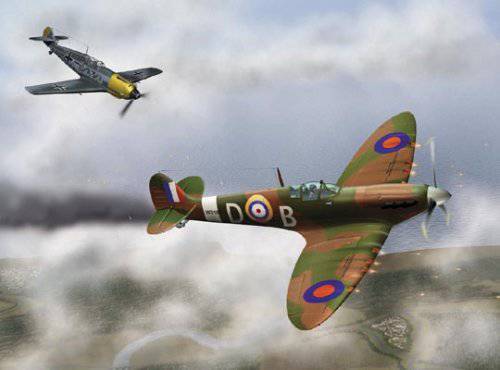
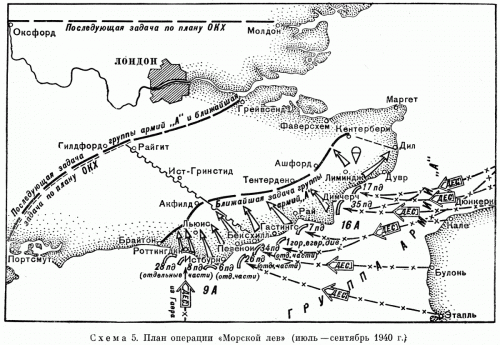
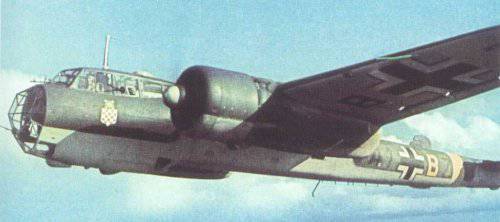
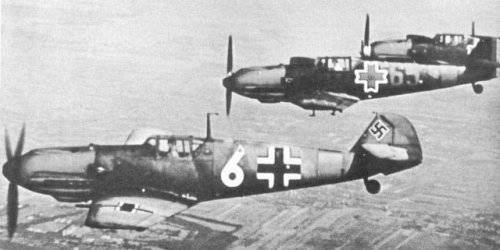
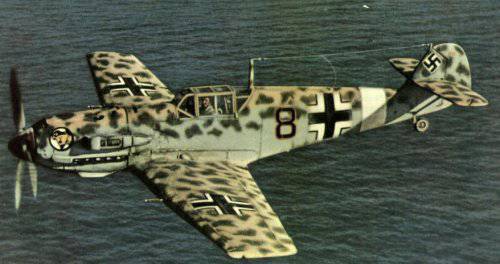
Information